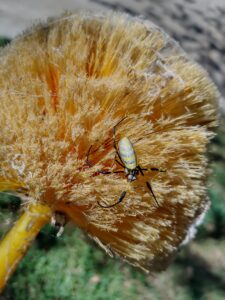The Joro spider

If you live in North Georgia, you may have noticed large, vibrant spiders spinning intricate webs in your garden or along trails in the past few years. These are Joro spiders, an invasive species that has recently made North Georgia its home. While their striking appearance may be alarming to some, these spiders are generally harmless to humans and are fascinating creatures with an interesting backstory. Here’s what you need to know about the Joro spider and its growing presence in the region.
The Joro spider (*Trichonephila clavata*) is native to East Asia, particularly in Japan, Korea, and China. It is easily identifiable due to its bold colors: a bright yellow body with blue-black stripes and striking red markings near its abdomen. Females, which are much larger than males, can grow up to 3 inches long, not including their legs. Their webs are often just as impressive, spanning several feet in width, and are made of golden silk that glimmers in the sunlight.
The spider first appeared in Georgia around 2014 and has since spread across much of the state and into neighboring regions. Scientists believe they likely arrived accidentally, hitching a ride in shipping containers or other cargo arriving from Asia.
North Georgia offers the perfect environment for Joro spiders to thrive. The region’s mild climate, diverse habitats, and abundance of prey have allowed the species to establish itself quickly. Unlike other spider species, Joro spiders are particularly adept at adapting to new environments, which has contributed to their rapid spread.
Another reason for their success is their reproductive strategy. Joro spiders lay hundreds of eggs in the fall, which hatch in the spring, leading to a boom in their population during the warmer months. They are also ballooning spiders, meaning young spiders can travel long distances by floating on the wind using silk threads, helping them expand their territory quickly.
Are Joro Spiders Dangerous?
The good news is that Joro spiders are not dangerous to humans. While their size and vivid colors may seem intimidating, their venom is not harmful to people or pets. In fact, their venom is similar to that of the common orb-weaver spider, which is not considered medically significant.
Most people won’t experience any adverse reactions if bitten, and Joro spiders are not aggressive. They typically only bite if threatened or handled directly, so it’s best to leave them undisturbed.
The introduction of an invasive species always raises concerns about its impact on local ecosystems. So far, the Joro spider’s effect on North Georgia’s environment is still being studied. However, there is some optimism that these spiders may help control pest populations, as they primarily feed on insects such as mosquitoes, flies, and even invasive stink bugs, which are problematic for farmers.
Joro spiders may also compete with native spiders, but so far, there is no evidence that they are causing significant harm to local spider populations. Instead, some researchers believe they may actually help balance the ecosystem by preying on species that harm crops and native plants.
For many residents of North Georgia, the appearance of Joro spiders in their yards or gardens may be startling, but there’s no need to panic. In fact, they can be seen as beneficial, as they help reduce the numbers of pests. If you encounter one of their large webs, you can simply admire their intricate craftsmanship and respect their space.
However, if a Joro spider’s web is in an inconvenient location—such as across your front door or on a frequently used pathway—it’s easy to remove. Use a stick or long object to gently dislodge the web, and the spider will likely relocate without much fuss.
The arrival of Joro spiders in North Georgia is a reminder of how interconnected the world is and how quickly ecosystems can change. While they may seem like a nuisance to some, Joro spiders offer a unique opportunity to observe an exotic species up close. Understanding their role in the environment and learning to coexist with them will be key as they continue to spread throughout the region.
So, next time you spot a dazzling web glimmering in the sun, take a moment to appreciate the beauty and complexity of these newcomers to our local ecosystem. The Joro spider may have arrived uninvited, but it’s here to stay, weaving its way into the fabric of North Georgia’s natural landscape.
If you need assistance getting any creepy crawlies out of your home, give us a call at 770-479-1598.
Canton Termite is always happy to help keep your home pest-free!
